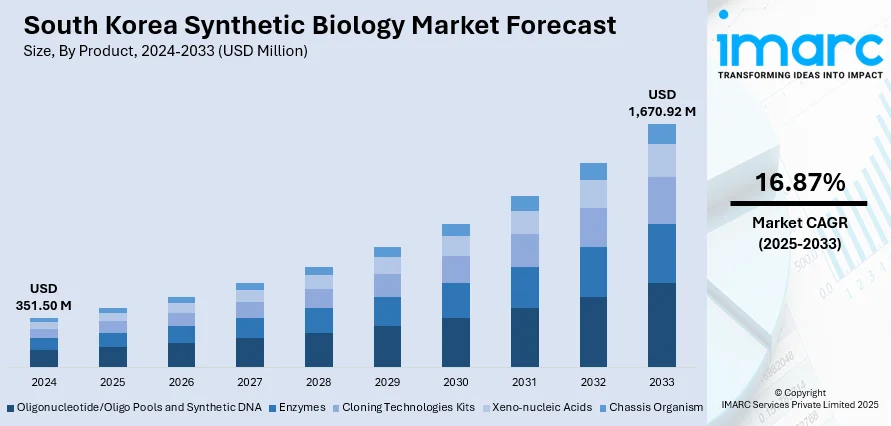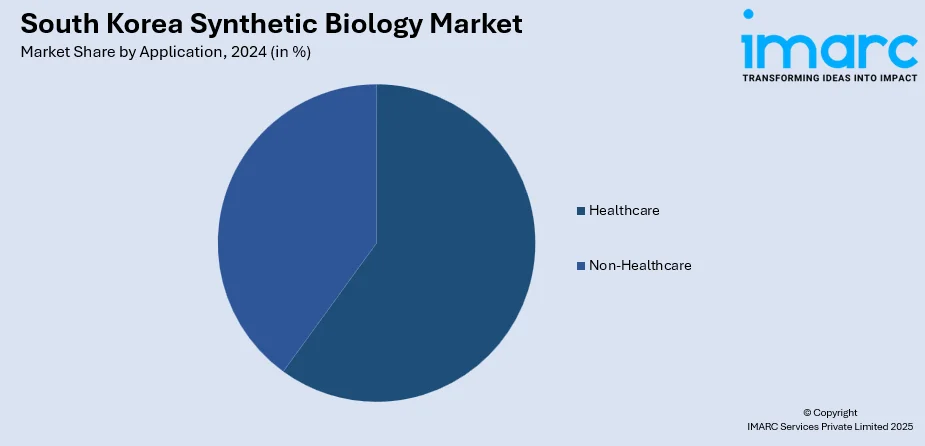
South Korea Synthetic Biology Market Size, Share, Trends and Forecast by Product, Technology, Application, and Region, 2026-2034
South Korea Synthetic Biology Market Overview:
The South Korea synthetic biology market size reached USD 351.50 Million in 2025. The market is projected to reach USD 1,670.92 Million by 2034, exhibiting a growth rate (CAGR) of 16.87% during 2026-2034. The industry is witnessing significant growth fueled by technological advancements in genetic engineering, growing investments in biotech research and development, and strengthened demand for eco-friendly solutions in healthcare, agriculture, and industry. Leading players are concentrating on emerging technologies, collaborative research, and broadening applications to enhance competitive strength. Strategic alliances and government initiatives also add to market growth, helping the growing South Korea synthetic biology market share.
|
Report Attribute
|
Key Statistics
|
|---|---|
|
Base Year
|
2025
|
|
Forecast Years
|
2026-2034
|
|
Historical Years
|
2020-2025
|
| Market Size in 2025 | USD 351.50 Million |
| Market Forecast in 2034 | USD 1,670.92 Million |
| Market Growth Rate 2026-2034 | 16.87% |
South Korea Synthetic Biology Market Trends:
Strengthened National Policy Support
In April 2025, South Korea took a major step in formalizing its commitment to biotechnology by passing the Synthetic Biology Promotion Act, the first legislation in the world dedicated solely to synthetic biology. This landmark policy lays the groundwork for long-term development by supporting core infrastructure like public bio foundries, national data-sharing standards, and specialized talent pipelines. It reflects a broader strategy to coordinate national research capabilities and scale them into global competitiveness. While the law provides structure, its real strength lies in enabling faster and more effective collaboration across government, academia, and research institutions. The Presidential Bio Committee, launched earlier that year, is also central to this shift aligning regional innovation clusters and guiding the implementation of national priorities. Together, these developments are driving institutional clarity and operational momentum across the field. With these foundational policies in place, South Korea is better positioned to lead in synthetic biology innovation. This strategic alignment is now shaping the long-term trajectory of South Korea synthetic biology market growth.

To get more information on this market, Request Sample
Infrastructure Scaling Through Bio Foundries
In January 2025, the South Korean cabinet approved a five-year, KRW billion initiative to establish a national bio foundry infrastructure aimed at advancing synthetic biology applications. This public investment brings much-needed scale to design–build–test workflows by integrating robotics, AI, and high-throughput automation enabling researchers to iterate genetic constructs more rapidly and reliably. With shared bio foundry platforms now connecting regional biotech hubs, labs across the country benefit from streamlined access to cutting-edge pipelines for strain engineering and biomanufacturing. The effort also supports modular prototyping of synthetic circuits in microbial hosts, accelerating transitions from experimental setups to industrial-grade processes. The result is a maturation in South Korea’s ecosystem not just academic research, but a move toward production-ready systems. As the government ensures centralized support and scalable infrastructure, it empowers a cohesive network of actors: from bench scientists to industrial users. This convergence of technical capability and strategic investment signals strong institutional backing, reinforcing foundational efforts behind South Korea synthetic biology market trends
DNA Synthesis Boom Spawns Innovation
In 2024, South Korea saw significant growth in its DNA synthesis industry, spurred by the increasing application of oligonucleotide and gene synthesis technologies in diagnostics and precision biosciences. The expansion is driving quicker prototyping of synthetic pathways and personalized gene constructs, enabling laboratories to speed up their research and development pipeline. Advancements in technology and falling costs have enabled a more efficient and nimbler platform for iteration and optimization of synthetic biology uses. This enables both commercial and academic developers as well as researchers to shorten the gap between conceptualization and testing to a cycle that occurs continuously. The growth of DNA synthesis capability is creating a more dynamic ecosystem for synthetic biology, enabling a broader set of practical applications and greater competitiveness at a global level. These advancements are well aligned with overall South Korea synthetic biology market growth trends, highlighting the nation's growing position in the development of next-generation biotechnology. Ongoing investment and adoption in this sector will be key to sustaining momentum and propelling future advancements in both research and marketization.
South Korea Synthetic Biology Market Segmentation:
IMARC Group provides an analysis of the key trends in each segment of the market, along with forecasts at the country and regional levels for 2026-2034. Our report has categorized the market based on product, technology, and application.
Product Insights:
- Oligonucleotide/Oligo Pools and Synthetic DNA
- Enzymes
- Cloning Technologies Kits
- Xeno-nucleic Acids
- Chassis Organism
The report has provided a detailed breakup and analysis of the market based on the product. This includes oligonucleotide/oligo pools and synthetic DNA, enzymes, cloning technologies kits, Xeno-nucleic acids, and chassis organism.
Technology Insights:
- NGS Technology
- PCR Technology
- Genome Editing Technology
- Bioprocessing Technology
- Others
A detailed breakup and analysis of the market based on the technology have also been provided in the report. This includes NGS technology, PCR technology, genome editing technology, bioprocessing technology, and others.
Application Insights:

- Healthcare
- Clinical
- Non-Clinical/Research
- Non-Healthcare
- Biotech Crops
- Specialty Chemicals
- Bio-Fuels
- Others
The report has provided a detailed breakup and analysis of the market based on the application. This includes healthcare (clinical and non-clinical/research) and non-healthcare (biotech crops, specialty chemicals, bio-fuels, and others).
Regional Insights:
- Seoul Capital Area
- Yeongnam (Southeastern Region)
- Honam (Southwestern Region)
- Hoseo (Central Region)
- Others
The report has also provided a comprehensive analysis of all the major regional markets, which include the Seoul Capital Area, Yeongnam (Southeastern Region), Honam (Southwestern Region), Hoseo (Central Region), and others.
Competitive Landscape:
The market research report has also provided a comprehensive analysis of the competitive landscape. Competitive analysis such as market structure, key player positioning, top winning strategies, competitive dashboard, and company evaluation quadrant has been covered in the report. Also, detailed profiles of all major companies have been provided.
South Korea Synthetic Biology Market News:
- April 2025: South Korea has passed the first law in the world to proactively promote synthetic biology. The new bill creates a national policy and annual plans to nurture development in the new field. It creates a government, academic, and industry expert council to guide development. The legislation also spurs development of biofoundries, workforce training, and global cooperation. The move aims at further cementing South Korea's position as an international leader in synthetic biology and AI-driven drug development, being mindful of the nation's emphasis on innovation.
- December 2024: LG Chem of South Korea has collaborated with Slovenia-based Acies Bio to move toward sustainable chemical production. The partnership is based on Acies Bio's OneCarbonBio™ platform, which converts one-carbon feedstocks such as CO₂, plastic waste, and biogas into high-value chemicals through upcycling. Merging the skills of Acies Bio in microbial biotechnology with LG Chem's in large-scale production and global market availability, the partnership targets bio-based replacements for chemical products, leading the chemical industry toward sustainability.
South Korea Synthetic Biology Market Report Coverage:
| Report Features | Details |
|---|---|
| Base Year of the Analysis | 2025 |
| Historical Period | 2020-2025 |
| Forecast Period | 2026-2034 |
| Units | Million USD |
| Scope of the Report |
Exploration of Historical Trends and Market Outlook, Industry Catalysts and Challenges, Segment-Wise Historical and Future Market Assessment:
|
| Products Covered | Oligonucleotide/Oligo Pools and Synthetic DNA, Enzymes, Cloning Technologies Kits, Xeno-nucleic Acids, Chassis Organism |
| Technologies Covered | NGS Technology, PCR Technology, Genome Editing Technology, Bioprocessing Technology, Others |
| Applications Covered |
|
| Regions Covered | Seoul Capital Area, Yeongnam (Southeastern Region), Honam (Southwestern Region), Hoseo (Central Region), Others |
| Customization Scope | 10% Free Customization |
| Post-Sale Analyst Support | 10-12 Weeks |
| Delivery Format | PDF and Excel through Email (We can also provide the editable version of the report in PPT/Word format on special request) |
Key Questions Answered in This Report:
- How has the South Korea synthetic biology market performed so far and how will it perform in the coming years?
- What is the breakup of the South Korea synthetic biology market on the basis of product?
- What is the breakup of the South Korea synthetic biology market on the basis of technology?
- What is the breakup of the South Korea synthetic biology market on the basis of application?
- What is the breakup of the South Korea synthetic biology market on the basis of region?
- What are the various stages in the value chain of the South Korea synthetic biology market?
- What are the key driving factors and challenges in the South Korea synthetic biology market?
- What is the structure of the South Korea synthetic biology market and who are the key players?
- What is the degree of competition in the South Korea synthetic biology market?
Key Benefits for Stakeholders:
- IMARC’s industry report offers a comprehensive quantitative analysis of various market segments, historical and current market trends, market forecasts, and dynamics of the South Korea synthetic biology market from 2020-2034.
- The research report provides the latest information on the market drivers, challenges, and opportunities in the South Korea synthetic biology market.
- Porter's five forces analysis assist stakeholders in assessing the impact of new entrants, competitive rivalry, supplier power, buyer power, and the threat of substitution. It helps stakeholders to analyze the level of competition within the South Korea synthetic biology industry and its attractiveness.
- Competitive landscape allows stakeholders to understand their competitive environment and provides an insight into the current positions of key players in the market.
Need more help?
- Speak to our experienced analysts for insights on the current market scenarios.
- Include additional segments and countries to customize the report as per your requirement.
- Gain an unparalleled competitive advantage in your domain by understanding how to utilize the report and positively impacting your operations and revenue.
- For further assistance, please connect with our analysts.
 Request Customization
Request Customization
 Speak to an Analyst
Speak to an Analyst
 Request Brochure
Request Brochure
 Inquire Before Buying
Inquire Before Buying




.webp)




.webp)












